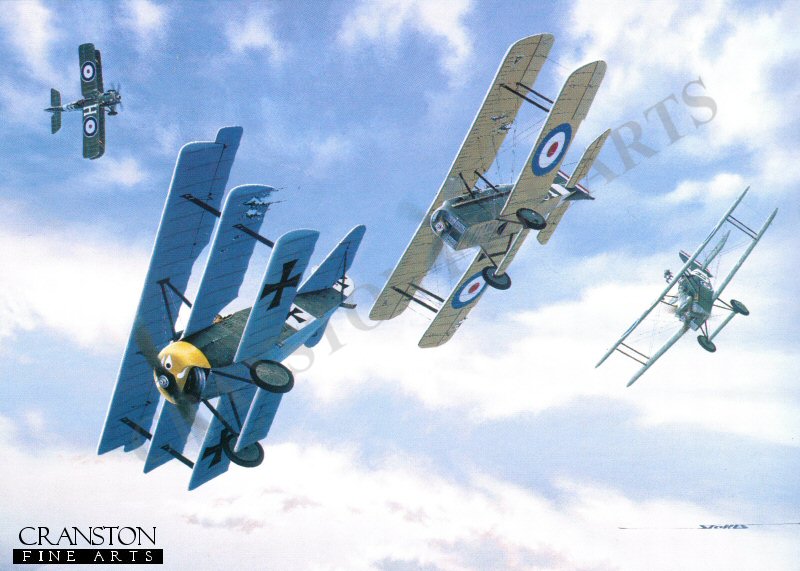- Sku:
- Vendor: Military Aviation Art Prints
Magnificent Courage by Stan Stokes.
On April 6, 1916 the RFC formed several new squadrons, including the No. 56 Squadron - Scouts. In March of 1917 the unit received the first of its new SE5s. The aircraft was disappointing to the pilots, being slower than expected, and its new Vickers machine gun with interrupter gear was next to useless. Many modifications ensued in the field, and many SE5s were fitted with Lewis guns located atop the upper wing, and in some cases an additional Lewis was installed which could be fired downward through the cockpit. In early April of 1917 No. 56 was ready to see its first combat action, and the unit headed off to France. About nine months earlier the pendulum of air superiority had swung back to the Germans. The Fokker scourge of 1915 had previously been negated by the deployment of DH2 and FE8 aircraft, but the newer German Albatros and Halberstadt fighters had regained the upper hand. The RFC was once again suffering unsustainable casualties. No. 56 Squadron was immediately pressed into service upon its deployment in France, and over the next several months gave a good account of itself. The Squadrons first victory came on April 22, and went to Albert Ball who would become a high scoring ace. On September 23, 1917 many of No. 56 Squadrons pilots would become engaged in what would be considered as one of the epic battles of early aerial warfare. At about 5:00 PM in the evening eleven SE5s took off for a routine patrol. There were heavy clouds at 9,000 feet, effectively limiting the ceiling. Several engagements took place prior to James McCudden noticing a lone SE5 from No. 60 Squadron under attack by a German triplane. Unknown to McCudden was the fact that the triplane was piloted by Werner Voss, a top German ace with 48 confirmed victories. During the next several minutes 7 SE5s focused their efforts on attacking Voss triplane. Voss had several opportunities to make a dash for the German lines, but chose to stay and fight. Demonstrating beautiful flying and determination, Voss held the massed SE5s at bay, and managed to inflict damage on each and every one. With maneuvers made so quickly and so unpredictably, none of the SE5 pilots could keep Voss in their gunsights long enough to fire a meaningful burst. Voss managed to damage two of the SE5s enough that they withdrew from the fight, and a red-nosed German Albatros joined in the fray for a short time. At one point in the battle McCudden indicated that the triplane was in the cone of tracer bullets from at least five machines simultaneously. Voss could out climb and outmaneuver all the RFC craft. Minutes later at about 2,000 feet the SE5 piloted by Arthur Rhys Davids managed to catch the German ace in a straight flat dive, and approached to within feet of the triplanes tail, firing a solid burst before pulling out of his dive. Moments later the triplane hit the ground and disintegrated. Later that evening the pilots of 56 Squadron recounted the epic battle speculating as to who might have been the pilot of the German triplane. The next morning General Trenchard sent an aide to 56 Squdron to elicit details of the battle. In this report James McCudden paid the following tribute to Voss, As long as I live I shall never forget that German pilot who single-handedly fought seven of us for ten minutes, and who put some bullets through all our machines. His flying was wonderful, his courage magnificent, and in my opinion he is the bravest German airman whom it has been my privilege to see fight.
Supplied with signed and numbered certificate of authenticity.
Signed limited edition of 4750 prints.
Print size 16 inches x 11.5 inches (41cm x 30cm)
Have a question?

Magnificent Courage by Stan Stokes.


